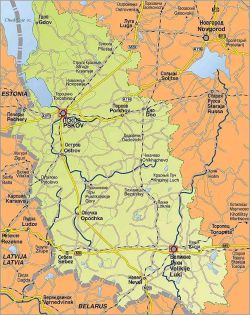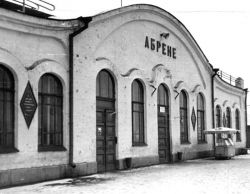Soviet Intelligence Documents Testify Abrene Region is Latvian Territory
Simon Araloff, AIA European section
"They'll get the ears of the dead donkey, and not Abrene."
—Vladimir Putin, press conference, May 2005.
In May 2005, the issue of control over Pytalovo (Abrene) district emerged as the main obstacle on the way to signing an agreement for the State border between Russia and Latvia. Moscow refused to recognize legitimacy of the Latvian reclamation of this territory. Secret documents of the Soviet intelligence that happened to reach the author of this article give evidence: during the World War II, position of the Russians in this issue was different. Soviet intelligence considered Abrene a part of the Latvian territory…
On the banks of Mudve river
Russian historical science traditionally calls the lands of Pskov region "indigenously Russian territory". A vivid example to this is the book by Boris Ribakov that was published in the Soviet time – Kievskaya Rus I Russkie Kniajestva (Kievan Rus and the Russian Dukedoms, 1982). This book tells of resettlement of the Slavs, the predecessors of the modern Russians, in the district of Chudskoe and Ilmen lakes. However, nothing is said about the peoples that were driven out of there or extinguished by the Slavs. Numerous examples of such a preconceived attitude towards history can be found on the modern Russian historical websites. One such instance is the article "The history of Pskov region" published in July 2005 on the "Russian civilization" website, claiming that this region is part of the most ancient Russian lands.
Meanwhile, in reality the history of Pskov region is somehow different from what the Russians present. Before the latter emerged here approximately in the 9th century AD, this area was inhabited by the peoples of Finno-Ugric and Baltic origin, kin to modern Estonians, Latvians, and Lithuanians. Ancient Latvians inhabited the riverside of Velikaya river, located in the very center of Pskov region. Its ancient Latvian name is Mudve, "the fast river". In the same location was the ancient Latvian dukedom called Adeles. A lot of geographical names in this area till today are of a non-Slavic origin, in many cases having Baltic roots - Drisa, Dzisna, Jazna, Jelna, Kleva, Osveja, Plisa, Sebeþa, Sula, Vedega. Regardless of this fact, the Russian historiography does not at all mention the ancient Latvian inhabitants of the western districts of Pskov region. Thus, Ribakov's book mentions the peoples of Finno-Ugric origin that lived to the north of Pskov. However, there is not a single word in it about the population of the Baltic origin, which lived on the territories invaded by the Russians.
Today it is clear that the reason for such a silence of the Soviet and the modern Russian historians is totally political. Acknowledging a historical link of the Latvians with the western districts of Pskov region, Moscow would automatically lose its main argument, by which it motivated the annexation of this territory in 1944. Then the argument was to return "the indigenously Russian lands" that were lost by the Bolshevik Russia in 1920.
Myth of the landlord Pytalov's heritage
History of Pytalovo regional center, after which the disputable region was called, begins at the end of the 18th century, during the reign of the Russian Empress Catherine the Great. According to a well-known Russian legend, Catherine granted the local lands to the officer of the Emperor's Army Pytalov, who then built his mansion here. However, the real meaning of this toponym is completely different. Actually, in the ancient times, the nearby Latvian territory was called Tālava (a legend about a trumpeter from Tālava is very popular in Latvia). Correspondingly, the Latvians called the territory of today's Pytalovo district "Pie Tālava", which means "near Tālava". The irony is in the fact that today the Russians use this name, being unaware of its Latvian origin. It is also worth mentioning that in the Russian archives there is no mention of the mythical officer Pytalov. The first landowner of Pytalovo was another person.
The first mention of Pytalovo in the Russian documents is dated 1782. In that period, the area surrounding Pytalovo was inhabited by plural Russian and Latvian population. Local Latvians kept active ties with their relatives in the neighboring area, called Latgale. The border between the two areas that were both part of the Russian Empire was open. Therefore, it is possible to talk of a common realm inhabited by the Latvians, including western districts of Pskov region.
In 1920, while establishing their own independent state, the Latvians demanded from the Bolshevik Russia to return them their historical lands inhabited by their compatriots. This demand laid in the basis of the so-called Riga Peace Agreement (1920). According to this agreement, Pytalovo and its surroundings were submitted to independent Latvia. Pytalovo was first renamed into Jaunlatgale, later into Abrene (1938). According to the population census of 1935, some 109,646 people were living in Abrene district, out of whom 60,145 (55%) were Latvians; 45,885 (41.6%) were Russians; and 648 (0.6%) Belarusians. There were also Jews, Poles, Estonians, and some other nationalities. The town of Abrene was inhabited by 1,242 people. Inhabitants of this region were economically very strongly connected to the rest of Latvia.
At the end of the World War II, after the repeated invasion of the Latvia's territory (second half of 1944), the Soviet authorities gave Abrene its old Russian name of Pytalovo. Annexing it to Pskov region was carried out following a directive from Moscow from November 21, 1944. As there was no independent Latvia any longer, Moscow did not plan to follow the agreement that had been signed with it in 1920. Together with Abrene, a number of other Latvian localities were annexed by Russia: Kacēni (Kachanovo), Upmale, Unava (Tolkovo), Pūrmale (Bokovo), Augšpils (Vishgorodok), Gauri (Gavry), Punduri (Ponderi). Part of the Latvian population left these localities at the end of the war. The other Latvians were systematically driven out of there by the Soviet authorities from the first post-war days. As a result, in 1945, the Latvians constituted only 12.5% of Pytalovo's population. In 1985, some 10 thousand people were living in the town of Pytalovo, practically all of them Russian. In total, Russia annexed just under 1,300 square kilometers of Abrene1, about half the size of Luxembourg.
Soviet intelligence versus intelligence officer Putin
First of all, we draw attention to the following interesting fact. Practically in all the documents (and there are many dozens of them) Abrene region is called by its Latvian name, and not by its Russian name, Pytalovo. For example, the document that tells about work of the Soviet Partisan Movement agents in the Latvian territory during the WWII, notifies that some 237 agents were acting in Abrene region (Photocopy no. 1). Another document, which concerns the creation of the first Latvian partisan brigade, informs that it is acting "in the northern part of Latvia", from Abrene to Valmiera. The document about deployment of the agent subversive network of the Soviet intelligence in the Latvian territory tells about the work in Abrene region of the group commanded by Petr Petrov (Photocopy no. 2).
It is noteworthy that other localities in the Abrene region are also mentioned in these documents by their Latvian names. For example, in the summary of intelligence information of the Partisan Movement Central Staff from October 1943, the locality Vishgorodok is mentioned as Augšpils. In the dispatch of Soviet intelligence resident Maksimov from August 1944 concerning agent recruitment in Abrene region, the Latvian name of the railway station Punduri is mentioned (Photocopy no. 3).
It is worth mentioning in this connection that in the internal correspondence of the Soviet intelligence, at the command level, Abrene region is mentioned as a Latvian territory. For example, on June 20, 1944, the director of the intelligence department of the Second Baltic Front, Colonel Maslov received a summary about the enemy forces in the Latvian territory. Among other facts, the following localities were mentioned in this summary as the Latvian territory: Punduri, Gavry, and Augšpils, as well as Jaunlatgale, which is Abrene. At the same time, the districts of Gavry, Karsava, Ludza, and Rezekne (the latter three are today located in the territory of Latvia) and Vilaka, Jaunlatgale, Gavry (the first one of them is located in the territory of Latvia) are mentioned as the integrated territorial units, which they were in reality (Photocopy no. 4).
Thus, reading these and other documents of the Soviet intelligence apparatus, one get the unmistakable impression that they tell about the activity in the territory of Latvia. Nowhere—in none of these documents—Abrene region is called the Russian territory. Such approach completely confronts position of the Russian President Vladimir Putin, who states that Latvia's territorial reclamation of Abrene region is baseless. Accordingly, position of the Latvian politicians, who insist on historical right of their country to return Abrene, appears to be completely well-grounded.
In spite of the fact that the above-mentioned documents have no legal power, they clearly testify that Abrene region was invaded after the WWII, and not "returned" to Russia. During the war no one, even the Soviet intelligence Command, had any doubts that this region belonged to Latvia.
Additional reading
- Russia angered by Latvia`s position on border
- The border question: Latvians are not ready to follow the Estonian lead
The AXIS site is no longer active. Its domain name was taken over in 2005 by Japanese click-bait. Links to other AXIS articles from this copy-edited archival copy have been directed to web.archive.org.
| 1 | The original article indicated 2,000 sq. km. |
 Gallery
Gallery





